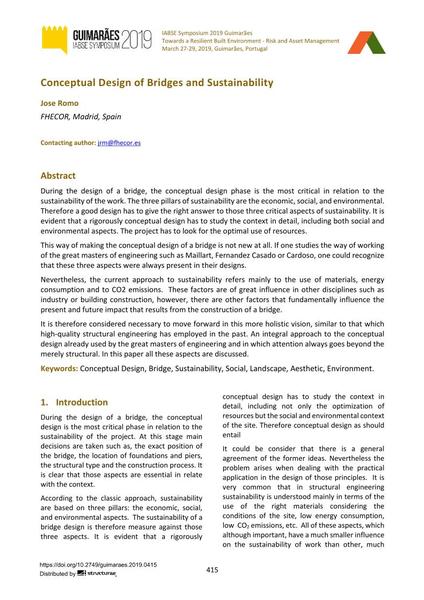Conceptual Design of Bridges and Sustainability

|
|
|||||||||||
Détails bibliographiques
| Auteur(s): |
José Romo
(FHECOR, Madrid, Spain)
|
||||
|---|---|---|---|---|---|
| Médium: | papier de conférence | ||||
| Langue(s): | anglais | ||||
| Conférence: | IABSE Symposium: Towards a Resilient Built Environment Risk and Asset Management, Guimarães, Portugal, 27-29 March 2019 | ||||
| Publié dans: | IABSE Symposium Guimarães 2019 | ||||
|
|||||
| Page(s): | 415-424 | ||||
| Nombre total de pages (du PDF): | 10 | ||||
| DOI: | 10.2749/guimaraes.2019.0415 | ||||
| Abstrait: |
During the design of a bridge, the conceptual design phase is the most critical in relation to the sustainability of the work. The three pillars of sustainability are the economic, social, and environmental. Therefore a good design has to give the right answer to those three critical aspects of sustainability. It is evident that a rigorously conceptual design has to study the context in detail, including both social and environmental aspects. The project has to look for the optimal use of resources. This way of making the conceptual design of a bridge is not new at all. If one studies the way of working of the great masters of engineering such as Maillart, Fernandez Casado or Cardoso, one could recognize that these three aspects were always present in their designs. Nevertheless, the current approach to sustainability refers mainly to the use of materials, energy consumption and to CO₂ emissions. These factors are of great influence in other disciplines such as industry or building construction, however, there are other factors that fundamentally influence the present and future impact that results from the construction of a bridge. It is therefore considered necessary to move forward in this more holistic vision, similar to that which high-quality structural engineering has employed in the past. An integral approach to the conceptual design already used by the great masters of engineering and in which attention always goes beyond the merely structural. In this paper all these aspects are discussed. |
||||
| Mots-clé: |
pont durabilité
|
||||
